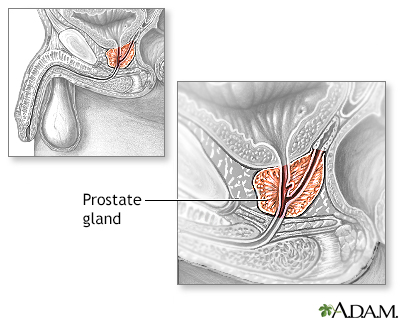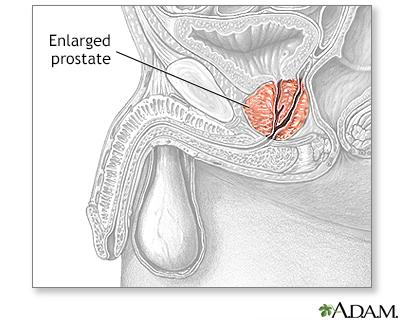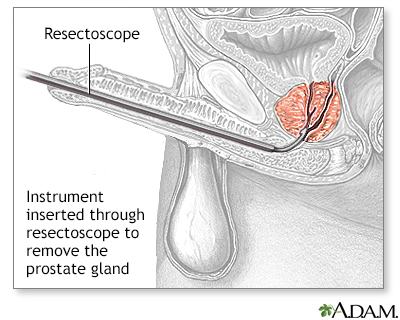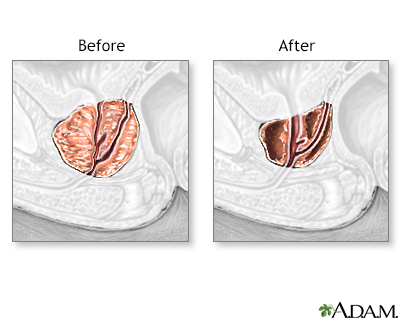Transurethral resection of the prostate - discharge
You had transurethral resection of the prostate (TURP) surgery to treat an enlarged prostate. This article tells you how to take care of yourself at home after the procedure.
When You're in the Hospital
You had transurethral resection of the prostate (TURP) surgery to treat an enlarged prostate.
Transurethral resection of the prostate...
Transurethral resection of the prostate (TURP) is a surgery to remove the inside part of the prostate gland. It is done in order to treat symptoms o...

Your surgeon inserted a tube-like tool called a cystoscope (or endoscope) through your urethra (the tube that carries urine from the bladder out of the penis). Your surgeon used a special cutting tool to remove part of your prostate gland piece by piece.
What to Expect at Home
You can expect to start doing most of your normal activities in 3 to 6 weeks. Problems you may notice include:
- Problems with urine control or leakage after sneezing, coughing, or lifting.
-
Erection problems (impotence).
Erection problems
An erection problem occurs when a man cannot get or keep an erection that is firm enough for intercourse. You may not be able to get an erection at ...
 ImageRead Article Now Book Mark Article
ImageRead Article Now Book Mark Article - Absence of semen or decrease in volume. Semen travels up into the bladder instead of out through the urethra. This is called retrograde ejaculation. It is not harmful but can interfere with your ability to get women pregnant. It can be permanent.
- Burning or pain during urination.
- Passing blood clots.
Self-care
You should rest as often as you need to the first few weeks after surgery. But you should also do regular, short periods of movement to build up your strength. While resting, continue to do some of the bedside exercises and breathing techniques your nurse showed you.
Gradually return to your normal routine. You should not do any strenuous activity, lifting (more than 5 pounds or more than 2.3 kilograms), or driving for 3 to 6 weeks.
Try taking regular, short walks. Work up to longer walks to build up your strength. You can return to work when you are better and can tolerate most activities.
Drink plenty of water to help flush fluids through the bladder (8 to 10 glasses a day). Avoid coffee, soft drinks, and alcohol. They can irritate your bladder and urethra.
Eat a healthy diet with plenty of fiber. You may use a stool softener or fiber supplement to help prevent constipation, which can delay the healing process.
For the first few weeks after surgery, take only the medicines your health care provider has told you to take.
- You may need to take antibiotics to help prevent infection.
- Check with your surgeon before taking aspirin, ibuprofen (Advil, Motrin), naproxen (Aleve, Naprosyn), acetaminophen (Tylenol), or any other medicines like these.
You may take showers. If you have a catheter, do not take baths until it is removed. Make sure your surgeon clears you for baths to make sure your incisions are healing well.
Avoid sexual activity for 3 to 4 weeks. Many men report a lower amount of semen during orgasm after having TURP.
Urinary Catheters
You may feel spasms in your bladder and may feel like you need to urinate while you have a urinary catheter in place. Your provider can give you medicine for these spasms. You may have urine come out around the catheter because of the bladder spams. This is normal.
You will need to make sure your indwelling catheter works right. You will also need to know how to clean the tube and the area where it attaches to your body. This will prevent infection and skin irritation. There should be urine draining and filling the bag if the catheter is working properly. Contact your surgeon if you have not seen any urine drain in an hour.
Indwelling catheter works right
You have an indwelling catheter (tube) in your bladder. "Indwelling" means inside your body. This catheter drains urine from your bladder into a ba...
Read Article Now Book Mark ArticleThe urine in your drainage bag may look darker red. This is normal.
After your catheter is removed:
- You may have some urine leakage (incontinence). This should get better over time. You should have close-to-normal bladder control within 3 to 6 months.
Incontinence
Urinary (or bladder) incontinence occurs when you are not able to keep urine from leaking out of your urethra. The urethra is the tube that carries ...
 ImageRead Article Now Book Mark Article
ImageRead Article Now Book Mark Article - You will learn exercises (Kegel exercises) that strengthen the muscles in your pelvis. You can do these exercises any time you are sitting or lying down.
Kegel exercises
Kegel exercises can help make the pelvic floor muscles under the uterus, bladder, and bowel (large intestine) stronger. They can help both men and w...
Read Article Now Book Mark Article
When to Call the Doctor
Contact your surgeon if:
- You have pain in your belly that is not helped with your pain medicines
- It is hard to breathe
- You have a cough that does not go away
- You cannot drink or eat
- Your temperature is above 100.5°F (38°C)
- Your urine has a thick, yellow, green, or milky drainage
- You have signs of infection (burning sensation when you urinate, fever, or chills)
Burning sensation when you urinate
Painful urination is any pain, discomfort, or burning sensation when passing urine.
 ImageRead Article Now Book Mark Article
ImageRead Article Now Book Mark ArticleChills
Chills refers to feeling cold after being in a cold environment. The word can also refer to an episode of shivering along with paleness and feeling ...
 ImageRead Article Now Book Mark Article
ImageRead Article Now Book Mark Article - Your urine stream is not as strong, or you cannot pass any urine at all
- You have pain, redness, or swelling in your legs
While you have a urinary catheter, contact your surgeon if:
- You have pain near the catheter
- You are leaking urine
- You notice more blood in your urine
Blood in your urine
Blood in your urine is called hematuria. The amount may be very small and only detected with urine tests or under a microscope. In other cases, the...
 ImageRead Article Now Book Mark Article
ImageRead Article Now Book Mark Article - Your catheter seems blocked and is not draining urine
- You notice grit or stones in your urine
Stones
A kidney stone is a solid mass made up of tiny crystals. One or more stones can be in the kidney or ureter at the same time.
 ImageRead Article Now Book Mark Article
ImageRead Article Now Book Mark Article - Your urine smells bad, or it is cloudy or a different color
Cloudy or a different color
The usual color of urine is straw-yellow. Abnormally-colored urine may be cloudy, dark, or blood-colored.
 ImageRead Article Now Book Mark Article
ImageRead Article Now Book Mark Article
Reviewed By
Kelly L. Stratton, MD, FACS, Associate Professor, Department of Urology, University of Oklahoma Health Sciences Center, Oklahoma City, OK. Also reviewed by David C. Dugdale, MD, Medical Director, Brenda Conaway, Editorial Director, and the A.D.A.M. Editorial team.
Benjamin TGR, Kreshover JE. Simple prostatectomy. In: Bishoff JT, Kavoussi LR, Kavoussi N, Bishoff T, eds. Atlas of Laparoscopic and Robotic Urologic Surgery. 4th ed. Philadelphia, PA: Elsevier; 2023:chap 30.
Krambeck A, Lee MS. Minimally invasive and endoscopic management of benign prostatic hyperplasia. In: Dmochowski RR, Kavoussi LR, Peters CA, et al, eds. Campbell-Walsh-Wein Urology. 13th ed. Philadelphia, PA: Elsevier; 2026:chap 151.
Strand DW, Roehrborn CG. Benign prostatic hyperplasia: etiology, pathophysiology, epidemiology, and natural history. In: Dmochowski RR, Kavoussi LR, Peters CA, et al, eds. Campbell-Walsh-Wein Urology. 13th ed. Philadelphia, PA: Elsevier; 2026:chap 149.
Disclaimer







 All rights reserved.
All rights reserved.